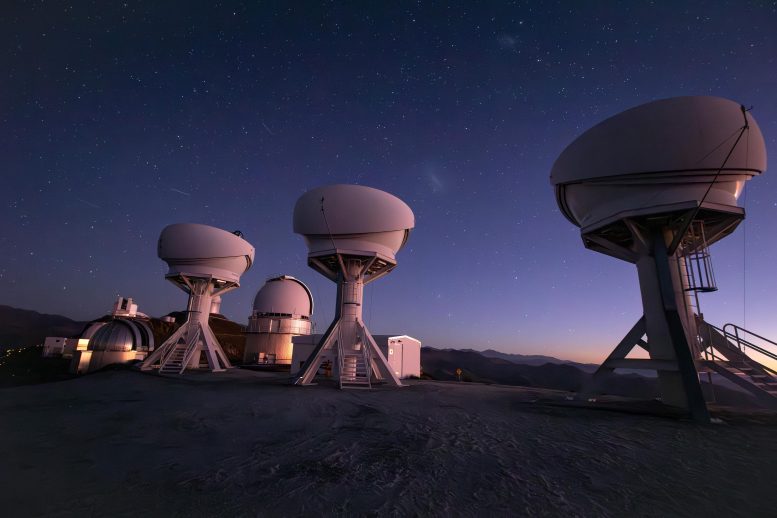
The BlackGEM array, consisting of three new telescopes located at ESO’s La Silla Observatory, has begun operations. This photograph shows the three open domes of the BlackGEM telescopes under a stunning night sky a La Silla. Other telescopes at the observatory are visible in the background. Credit: S. Bloemen (Radboud University)/ESO
The BlackGEM array, a system of three new telescopes located at the European Southern Observatory’s (ESO) La Silla Observatory, has begun operations to detect gravitational waves caused by cosmic events like black hole and neutron star mergers.
Unlike detectors such as LIGO and the Virgo Interferometer, BlackGEM can precisely locate these astronomical phenomena using visible light, enhancing our understanding of their processes, including the formation of heavy elements like gold and platinum.
The BlackGEM array, consisting of three new telescopes located at ESO’s La Silla Observatory, has begun operations. The telescopes will scan the southern sky to hunt down the cosmic events that produce gravitational waves, such as the mergers of neutron stars and black holes.
Some cataclysmic events in the Universe, such as the collision of black holes or neutron stars, create gravitational waves, ripples in the structure of time and space. Observatories like the Laser Interferometer Gravitational-Wave Observatory (LIGO) and the Virgo Interferometer are designed to detect these ripples. But they cannot pinpoint their origin very accurately nor see the fleeting light that results from the collisions between neutron stars and black holes. BlackGEM is dedicated to quickly scanning large areas of the sky to precisely hunt down gravitational-wave sources using visible light.
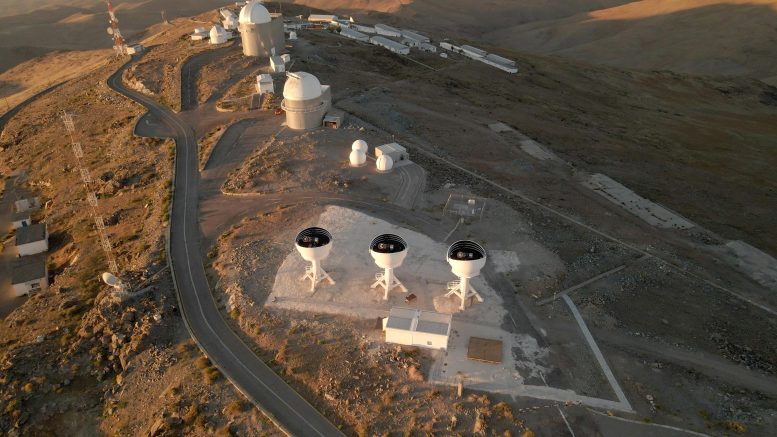
This drone shot, taken at ESO’s La Silla Observatory, shows a close-up of the open domes of the BlackGEM array. The three 65-cm telescopes that make up the array are visible inside. Credit: ESO
“With BlackGEM we aim to scale up the study of cosmic events with both gravitational waves and visible light,” says Paul Groot of Radboud University in the Netherlands, the project’s Principal Investigator. “The combination of the two tells us much more about these events than just one or the other.”
By detecting both gravitational waves and their visible counterparts, astronomers can confirm the nature of gravitational-wave sources and determine their precise locations. Using visible light also allows for detailed observations of the processes that occur in these mergers, such as the formation of heavy elements like gold and platinum.
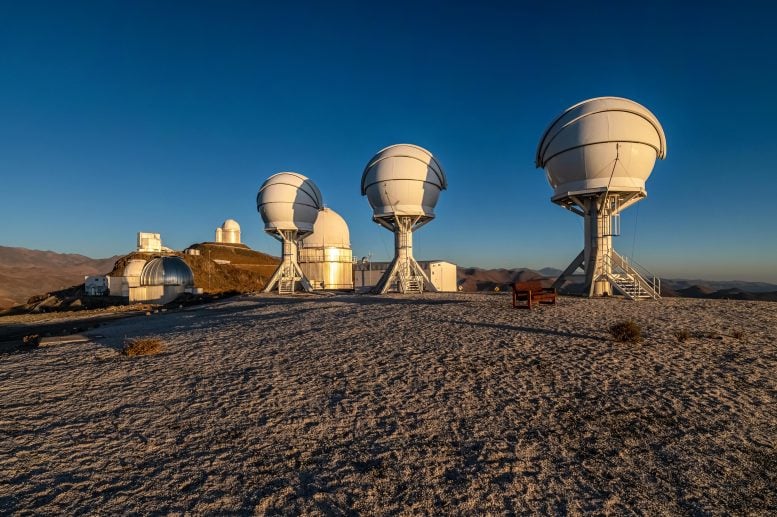
Shown in this image are the three telescopes of the BlackGEM array at ESO’s La Silla Observatory in Chile. The telescopes can quickly scan large areas of the sky to find a source that has emitted gravitational waves detected by LIGO and Virgo. Credit: Zdeněk Bardon (bardon.cz)/ESO
To date, however, only one visible counterpart to a gravitational-wave source has ever been detected. Furthermore, even the most advanced gravitational-wave detectors such as LIGO or Virgo cannot precisely identify their sources; at best, they can narrow the location of a source down to an area of approximately 400 full moons in the sky. BlackGEM will efficiently scan such large regions at high enough resolution to consistently locate gravitational-wave sources using visible light.
BlackGEM’s three constituent telescopes were built by a consortium of universities: Radboud University, the Netherlands Research School for Astronomy, and KU Leuven in Belgium. The telescopes are each 65 centimeters in diameter and can investigate different areas of the sky simultaneously; the collaboration eventually aims to expand the array to 15 telescopes, improving its scanning coverage even more. BlackGEM is hosted at ESO’s La Silla Observatory in Chile, making it the first array of its kind in the southern hemisphere.
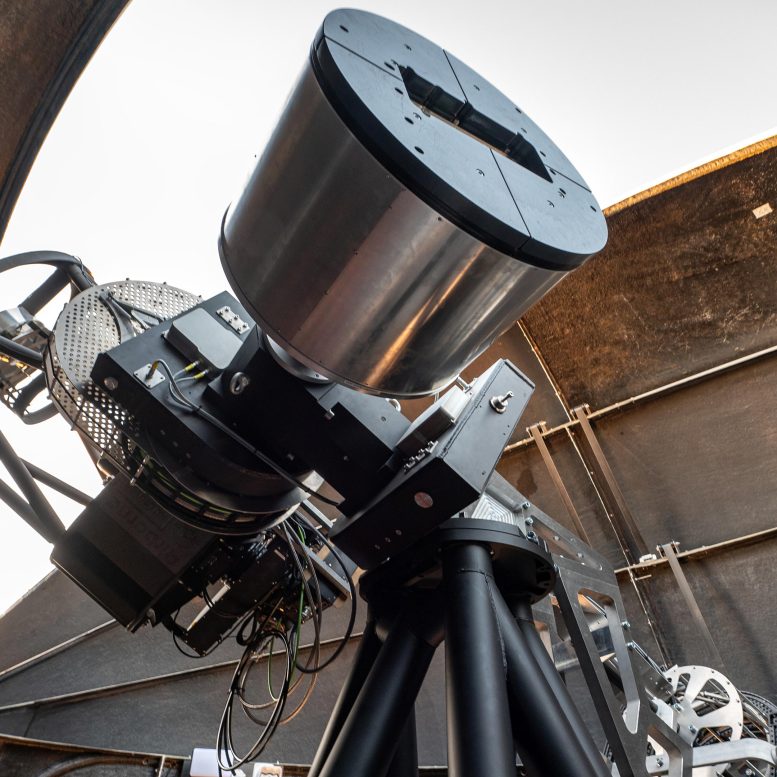
This photograph shows a BlackGEM telescope sitting inside its dome. The BlackGEM array, comprising three 65-cm telescopes, is located at ESO’s La Silla Observatory. Credit: ESO
“Despite the modest 65-centimeter primary mirror, we go as deep as some projects with much bigger mirrors, because we take full advantage of the excellent observing conditions at La Silla,” says Groot.
Once BlackGEM precisely identifies a source of gravitational waves, larger telescopes such as ESO’s Very Large Telescope or the future ESO Extremely Large Telescope can carry out detailed follow-up observations, which will help to shed light on some of the most extreme events in the cosmos.
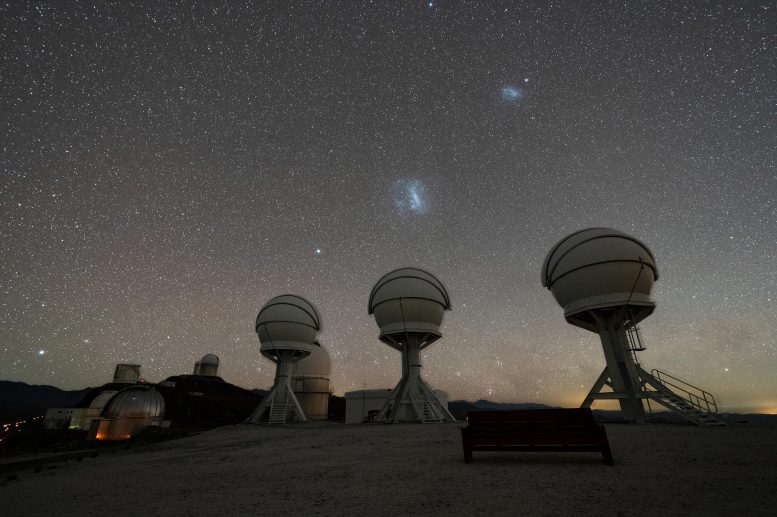
Shown in this nighttime image are the three telescopes of the BlackGEM array at ESO’s La Silla Observatory in Chile. The Large and Small Magellanic Clouds can be seen just above the telescopes. The BlackGEM array can quickly scan large areas of the sky to find a source that has emitted gravitational waves detected by LIGO and Virgo. Credit: ESO
In addition to its search for the optical counterparts to gravitational waves, BlackGEM will also perform surveys of the southern sky. Its operations are fully automated, meaning the array can quickly find and observe ‘transient’ astronomical events, which appear suddenly and quickly fade out of view. This will give astronomers deeper insight into short-lived astronomical phenomena such as supernovae, the huge explosions that mark the end of a massive star’s life.
“Thanks to BlackGEM, La Silla now has the potential to become a major contributor to transient research,” says Ivo Saviane, site manager at ESO’s La Silla Observatory. “We expect to see many outstanding results contributed by this project, which will expand the reach of the site for both the scientific community and the public at large.”
This montage of drone and stationary footage shows the three telescopes of the BlackGEM array at ESO’s La Silla Observatory in Chile. This site lies at an altitude of 2400 meters in the Atacama Desert and gives astronomers pristine observing conditions. The BlackGEM array can quickly scan large areas of the sky to find a source that has emitted gravitational waves detected by LIGO and Virgo. The telescopes were built by a consortium of universities: the Netherlands Research School for Astronomy, KU Leuven in Belgium and Radboud University. Credit: ESO
More information
The BlackGEM consortium comprises: NOVA (Netherlands Research School for Astronomy, the national Dutch alliance in astronomy between the University of Amsterdam, University of Groningen, Leiden University, and Radboud University); Radboud University, the Netherlands; KU Leuven, Belgium; the Weizmann Institute, the Hebrew University of Jerusalem and Tel Aviv University, Israel; the University of Manchester and the Armagh Observatory and Planetarium, UK; Texas Tech University, the University of California at Davis and the Las Cumbres Observatory, USA; the University of Potsdam, Germany; the Danish Technical University, Denmark; the University of Barcelona, Spain; and the University of Valparaíso, Chile.

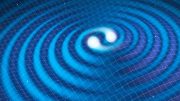


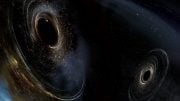

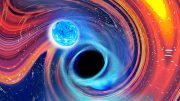
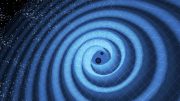

Black GEM means highly complicated .
Difficult also. This GEM,sent by me only.